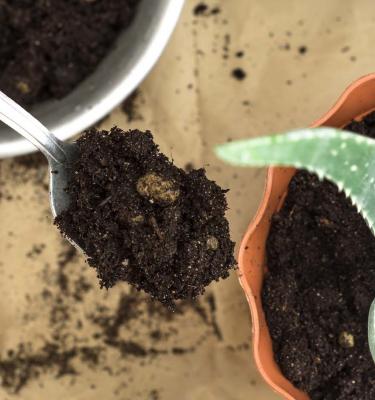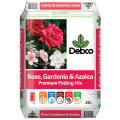When you walk down the potting mix aisle of your local hardware store or garden centre, it will quickly become obvious that there's an enormous range of indoor and outdoor potting mixes to choose from. They range in price and in quality so how do you know which one is right for your plants? Read on for tips and advice on how to pick the right potting mix for your indoor plants.
Why should you use quality potting mix for your indoor plants?
Indoor plant potting mix isn’t just a bag of dirt. Quality indoor plant potting mix is the result of extensive research, product development and precise manufacturing to ensure that your indoor plants are getting the nutrients that they need. There are four key elements that are vital to your plants health.
- Good drainage and the right levels of moisture
- Good structure so the roots can breathe
- Good support so the roots can spread out
- The right balance of nutrients
How to make sure you're buying the best potting mix
There are a few key features to look out for to ensure you are buying quality potting mix for your indoor plants.
- Look for the Australian Standards red tick as these products will best sustain a potted plant to promote quality growth, flowering and fruiting. The Scotts Osmocote potting mix range all have the Australian Standards red tick.
- Professional potting mix will be made with natural materials from renewable resources like woodchip or bark which is fully composted until it has rich dark soil like texture before special components are added. These materials will have your plants growing from day one.
Potting mix for indoor plants
Indoor plants are a great decorative element to add to any household and can also help improve air quality and mood around the house. It is important to plant indoor plants right from the start to ensure that they grow to become healthy and strong plants. The first step is to choose the right indoor plant potting mix, it is essential to select a quality potting mix to ensure that it encourages strong root development, has good water holding for circulation, good aeration for moisture retention and will also provide feeding for indoor plants for up to 6 months. Another key element in premium indoor plant potting mix is ensure that doesn’t shelter fungas gnats. The Scotts Osmocote Indoor Plant Potting Mix is especially formulated without compost or pine bark to be less prone to fungas gnats. Make sure that your plants are being watered frequently enough that the indoor potting mix is moist but not wet and avoid allowing plants to dry out. Plants should be repotted with new potting mix when they outgrow their pot or after 12-18 months.
It is important to use a quality indoor plant fertiliser that is fast and easy to apply and supplies a balanced range of plant nutrients. Adding Scotts Osmocote Pour + Feed to the roots of the indoor plants will provide them with the essential nutrients for optimum growth with visible results in 7 days. Some indoor plants such as orchids and cacti & succulents need a specific indoor plant fertiliser formulation to ensure they receive the essential nutrients they need.
Potting mix for different plants
It's estimated there is close to half a million different plant species found on Earth, occurring naturally over an extraordinary range of climates and soils - from the frozen polar regions to the tropics - so it's important to recognise this when you're trying to grow plants in pots, baskets, barrels or vertical/wall gardens at home.
Potting mixes are usually formulated to reproduce as closely as possible the soil conditions that plants prefer. While there are all purpose mixes that will be quite suitable for a vast array of different plants, there are some plants that require special mixes to meet their very specific needs.
For example, cacti and succulents are most often (but not always) found in dry, arid regions. The soil of these habitats is often very sandy or gravelly with little organic material or nutriment in it. When it rains, water soaks in and quickly disappears deep into the soil.
A cacti and succulent potting mix should therefore:
- Have a high percentage of coarse sand or grit
- Be free draining
- Be relatively nutrient-deficient
The same applies to other plant groups:
- Roses, azaleas, camellias and other acid-lovers need a potting mix with a pH around 5.2 to 5.9.
- Bonsai prefer a potting mix that drains well so roots don't rot but it must also hold enough moisture to sustain the plant.
- African violets need a low nitrogen, high potassium potting mix with added calcium to encourage continuous flowering.
Top tip when buying potting mix
Take the time to look at the multitude of bagged potting mixes available from your retailer to see what they're designed and recommended for. Consider this information in relation to the plants you have and buy accordingly.
What if I've bought the wrong potting mix?
In most instances, choosing the wrong potting mix probably won't have a major impact. For example, you've potted up carnations (which prefer a soil pH of 6.75 - 7) into a rose and azalea potting mix with a pH of 5.2! The carnations will not grow well, may yellow and will certainly not produce the abundance of flowers you would expect.
If you pot a cactus into an all purpose potting mix that doesn't contain added grit and is high in organic content and nutrients, it's likely it will sulk. It may rot around the base and fail to flower - it certainly won't grow as you would like it to.
Usually the best way to overcome these problems is to replace the potting mix with one that has been designed for the plants you have.
You could try one or more of the following:
- Add some coarse washed sand to 'open' the potting mix up so it drains more freely.
- Add garden lime (at the label rate) to raise the pH if the potting mix is too acidic.
- Mix in compost to increase water-holding and organic content.
Another top tip
If you've bought the wrong potting mix but only discovered your error when you're ready to use it, you may be able to adjust it to make it more suitable.










